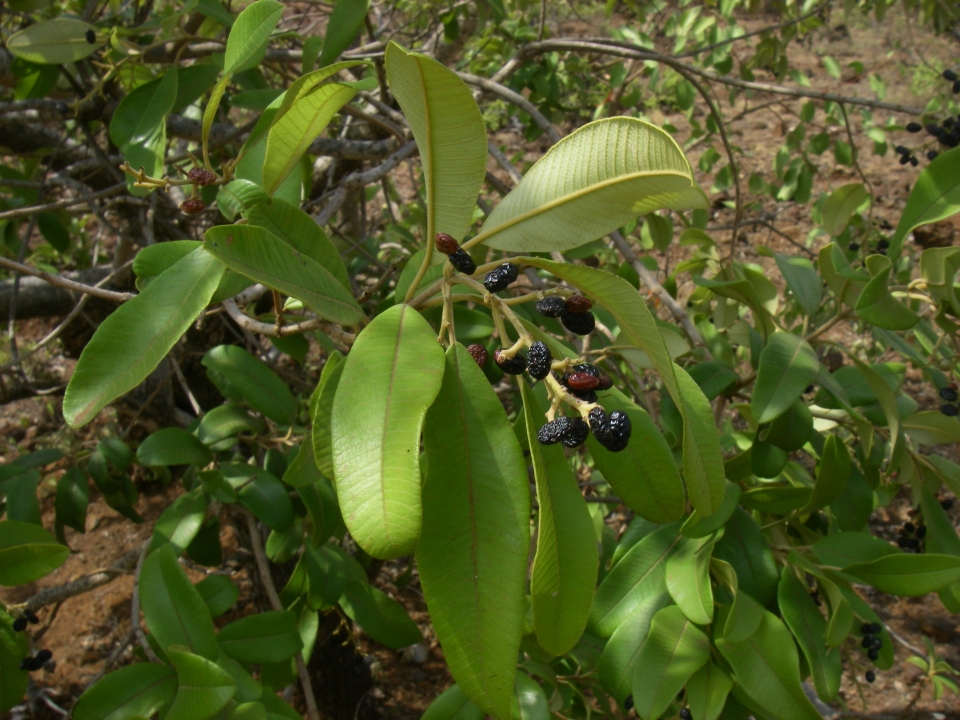Heeria insignis

|
|
Heeria insignis Common Names: Cork Bush, Witmossie, White Resin Tree Scientific
Classification Kingdom: Plantae Clade: Tracheophytes Clade: Angiosperms Clade: Eudicots Order: Sapindales Family: Anacardiaceae Genus: Heeria Species: H. insignis Synonyms: Ozoroa insignis Delile, Rhus insignis Delile, Anaphrenium abyssinicum Hochst. Morphological Description Heeria insignis is a woody shrub or small tree, typically growing 2–6 m
tall, occasionally reaching 10 m in favorable conditions. Its key morphological
features include: · Bark: Thick, corky, pale grey to light brown, peeling in strips,
exuding a milky latex when cut. · Leaves: Simple, opposite, oval to elliptic, 3–8 cm long, 1.5–4 cm
wide, glossy dark green above, paler beneath, with entire margins. · Flowers: Small, tubular, 3–5 mm long, white to pale yellow or pink,
arranged in axillary or terminal panicles; petals five, slightly fragrant. · Fruit: Capsule-like drupe, 5–8 mm in diameter, green turning
reddish-brown when ripe, containing 1–2 seeds. The corky bark and milky
sap are diagnostic traits within the Anacardiaceae family (Moffett, 1993). Distribution and Habitat Heeria insignis is native to sub-Saharan Africa, with a wide distribution
across: · West Africa: Senegal, Mali, Niger, Nigeria (southern savanna belt). · Southern Africa: South Africa (Limpopo, Mpumalanga),
Zimbabwe, Botswana. · East Africa: Tanzania, Kenya (rarer occurrences). It thrives in dry, rocky
terrains, savannas, and open woodlands, tolerating annual rainfall of 400–1,200
mm and sandy to loamy soils (pH 5.5–7.0). Its drought resistance suits it to
arid zones (Burkill, 1985). Ethnopharmacology Heeria insignis (synonymously known as Ozoroa insignis) is an indigenous African shrub extensively
utilized in traditional medicine across various regions. Traditional
applications of this plant encompass the treatment of diarrhea, venereal
diseases, tapeworm, hookworm, schistosomiasis, kidney ailments, and as a
galactagogue to enhance lactation in postpartum women. Phytochemical
investigations have identified the presence of secondary metabolites such as
alkaloids, flavonoids, tannins, terpenes, and phenolic compounds in Heeria
insignis. These compounds are known to contribute to the plant's medicinal
properties, including antibacterial, anti-inflammatory, and antidiarrheal
effects. Scientific evaluations have substantiated several traditional uses of
Heeria insignis. For instance, methanol and dichloromethane leaf extracts have
demonstrated notable antibacterial activity against various pathogens, with the
methanol extract exhibiting higher efficacy. Additionally, these extracts have
shown significant antidiarrheal activity in experimental models, supporting their
traditional application in managing diarrhea. · Antibacterial: Methanol leaf extracts inhibit Salmonella typhi (MIC 12.5 mg/ml), Pseudomonas aeruginosa, Staphylococcus aureus, Bacillus subtilis, and Escherichia coli, supporting its use for throat infections and
ulcers (Agunu et al., 2011). · Antidiarrheal: Leaf decoctions reduce castor oil-induced diarrhea in mice
by 60% (200 mg/kg), linked to tannins and flavonoids, validating its use for
diarrhea and dysentery (Agunu et al., 2011). · Anti-schistosomal: Bark and root extracts treat urinary
schistosomiasis in Nigeria. Ndamba et al. (1994) found molluscicidal activity
against Biomphalaria snails,
supporting its efficacy. · Anti-inflammatory: Leafy branch decoctions ease postpartum
pain and muscle aches in South Africa. Preliminary studies suggest saponins
reduce inflammation (Mabogo, 1990). · Renal/Hepatic: Root decoctions treat kidney and liver issues in Senegal.
Burkill (1985) notes diuretic effects, though clinical data are limited. Phytochemicals include
tannins, flavonoids, saponins, cardiac glycosides, and steroids, driving its
medicinal properties (Agunu et al., 2011). ⚠ Toxicity Profile: No specific toxicity studies exist for Heeria insignis. The milky latex may cause skin irritation, and
high doses of methanol extracts (>1,000 mg/kg) in mice showed mild liver
enzyme elevation (ALT up 15%) after 7 days. Use under guidance is advised
(Agunu et al., 2011). Additional Uses · Ecological: Stabilizes soil in arid regions and supports pollinators
like bees (Moffett, 1993). · Cultural: Corky bark used for crafting in South Africa; wood for fuel
and tool handles (Mabogo, 1990). · Livestock: Leaves browsed by goats, though latex limits palatability
(Burkill, 1985). References
External Links More Pictures |
|
| Compounds of Heeria insignis | |
| References |